“The most powerful enemy of justice is inertia.”
All posts by Art Martens
T.C. Knowles, War Hero and Citizen
In the game of life, Thomas (T.C.) Knowles of Hedley was not a bystander. After the death of his father, he emigrated to Canada in 1910 with his sister and brother-in-law from Glasgow, Scotland. Three years later, at the age of 20, he accompanied them to Hedley and worked in the Power House at the Daly Reduction Plant (gold mining company).
In 1915 a recruiter for the Canadian Army deeply stirred his patriotism. He and a number of young Hedley men eagerly enlisted. T.C. was assigned to the 54th Battalion.
According to Hedley researchers, Andy English and Jennifer Douglass, citizens of the town enthusiastically raised the equivalent of $75,000 in today’s currency to support the men in their war effort. Most of the funds were designated for machine guns and the local recruits became known as “the Hedley Machine Gun Boys.”
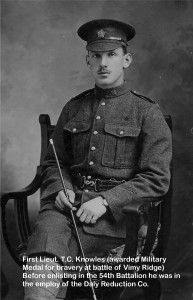
(photo from Knowles family collection)
T.C. was quickly promoted to Corporal and then Sergeant. His war diary, kept in a small notebook he carried throughout the war, reveals that he participated in major battles of WWI. On August 26, 1916 he wrote, “went into action at St. Eloi, Ypres.” Then on Oct. 11, “went into action at Corcelette (Somme).” March 1, 1917, he wrote, “regiment on large raid at Vimy Ridge. Very unsuccessful.” His daughter Anne Lloyd of Kamloops still has his diary and flying log.
T.C. proved to be a courageous soldier. On May 11, 1917 the London Gazette reported “his majesty the king has been graciously pleased to approve the award of the Military Medal for bravery in the field to Sergeant TC Knowles.” In 1917 he was seconded to the RAF where he trained as a pilot and patrolled the English Channel.
Demobilized on June 13, 1920, he was quite intact physically, emotionally and mentally. For a time he resumed his role as a steam engineer at the gold mining operation in Hedley. He married Thomasina (Ina) Boyd on August 24, 1922 and they raised 5 children in their home at 957 Ellis Ave. in Hedley.
In 1937 he was appointed to the position of Postmaster of Hedley. Here his zest for life and unique sense of humour at times surprised people. One favourite trick was to wear eyeglasses with false eyeballs that popped out and then retracted. Today’s postal regulations might not look kindly on such interactions with patrons.
In “Mines of the Eagle Country”, Doug Cox provides an insight into the nature and character of T.C.. He quotes Mary Smith, who lived with her husband high on the mountain at the Nickel Plate townsite. She said, “there was a wonderful man in Hedley, Tommy Knowles, the Post Master. We would send our cheques down to be cashed by him and ask him to pay our bill at the store. If there was something in the hardware, he would pay these bills and send the remaining money back. It would come up the skip.”
His son-in-law, Gordon Lloyd says, “when we were fishing at a pond in the river, if a fish came to his lure, he’d yank out the lure so the fish would come to mine.” According to Gordon, T.C. told people his success in fishing came from using Scottish worms soaked in whiskey and kept in the fridge overnight.
T.C. understood well that a community will be vibrant only if citizens are active in its organizations. He served as secretary-treasurer of the hospital society, chairman of the Cenotaph committee, and trustee and devoted member of the Grace United Church. He was also an active promoter and developer of the Hedley Golf Course. His wife “Ina” shared his community mindedness. According to daughters Beverly and Anne, she played the organ at church for 60 years.
T.C. had a wonderful ability to accept and interact with people of other cultures and races. According to Gordon Lloyd, when he passed away in 1959, there were as many people from the local reserve at the funeral as from Hedley. He and Thomasina, and other members of the family are buried in the Hedley Cemetery. To this day, those who remember T.C. and Thomasina Knowles, or know of them, still speak of them with a palpable sense of awe.
Hedley Hotels – Part 3 of 3
Although there were already 4 hotels in Hedley very early in the twentieth century, there was evidently sufficient business to warrant the construction of two more. In the summer of 1905 John Jackson built the New Zealand. For the most part the reasoning behind the names of the other hotels in Hedley can be understood. I have seen no explanation as to why a hotel in Hedley would be named the New Zealand. For the investors it proved to be a short-lived venture. In the early morning hours of November 6, 1911 it burned down.
In the fall of 1905 John Lind and the Peterson brothers leased a building from G.H. Sproule. After considerable reconstruction, they opened it in 1906 as the Great Northern Hotel.
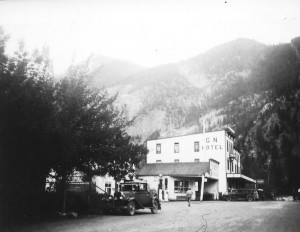
(photo from Hedley Museum collection)
Writing in the April, 1948 British Columbia Historical Quarterly, Harry D. Barnes observed that “Hedley now had six hotels, and for a few years there was business for them all. As was common in mining towns of the day, the hotel bars were kept open 24 hours a day and seven days a week.”
The Great Northern was no more fortunate than the other five Hedley hotels. In the winter of 1956-57, it also burned down.
Both the Mascot and Nickle Plate mines had ceased operations by this time, so the town was no longer in need of hotels. Although it seems unusual that three hotels burned down the year after the closing of the Nickle Plate, I have come across no suggestion that the demise of any of the hotels came about by suspicious circumstances. Also, I have come across no reports of injuries or deaths as a result of these fires.
With the closing of the mines and the burning of the hotels, Hedley lost its excitement and swagger, and many of its inhabitants. It became a town that attracted not seekers of wealth, but seekers of a quiet life away from the bustle and noise of city life.
Hedley Hotels – Part 2 of 3
Each time I visit the Hedley Museum (usually at least 2 times per week) I return to the wall where photos of several Hedley hotels are displayed. I recall being amazed when I first learned that there had been 6 hotels of note, as well as several smaller ones, now largely forgotten. Even today it continues to surprise me that our little town, which presently has about 250 inhabitants on a good day, was the hub of so much activity.
In addition to the two hotels mentioned in the previous post, a third, The Commercial, was constructed by C.E. Oliver and Associates in the fall of 1902. In 1911, this hotel almost met the same dismal fate as the other two. A front page story in the January 26, 1911 Hedley Gazette reads as follows:
“Hedley nearly came in for a rather serious blaze on Thursday night of last week. Fire started in Critcley’s shoeshop, a small building attached to the Commercial hotel. It is thought that a spark from the stove caught in a gunny sack curtain near by and it was beginning to go in lively shape when noticed by F.M. Gillespie and G. McEachern, who happened to be in the drugstore opposite and were looking in that direction. They rushed over and kicked in the door, where the gunny sack was blazing and the woodwork alongside was in flames. First thing they pulled down the curtain and stamped out the fire. Then, using the partially burned sacking they smothered the remaining flames.”
The hotel survived several other fire related incidents. It did burn down though, in 1956. I have not found a photo of the Commercial, so if anyone has one please contact me on the comment section of the blogsite.
A fourth hotel, The Similkameen, situated at the corner of Scott
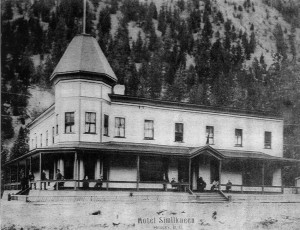
Avenue and 2nd Street, was built in 1904. The cost of $15,000. was a considerable sum at that time, and it was touted by the owners to be “the finest hotel in Hedley”. Writing in the April, 1948 edition of the British Columbia Historical Quarterly, Harry D. Barnes describes it as “a modern, well-built, and comfortable hotel.” He goes on to say “it soon became a popular stopping-place for travellers.”
On February 2, 1916 a fierce fire engulfed The Similkameen. Due to the intense cold, water pipes were frozen. In a futile attempt to control the blaze, desperate firefighters could do no more than throw buckets of snow on the conflagration. Only a few pieces of china marked “Similkameen Hotel” survived.
Hedley Hotels – Part 1 of 3
When gold was discovered on Nickel Plate Mountain in 1898, it attracted not only prospectors and miners, but also men with a variety of business ideas for cashing in on the bonanza. A few had the foresight to anticipate the coming demand for accommodation.
The first of these hoteliers was the enterprising D.G. Hackney who
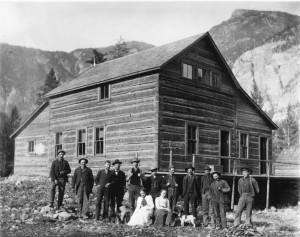
built the Hedley Hotel in the winter of 1900. Located on HaynesStreet directly across from the present day site of the Hedley Museum, it was constructed of hewn logs. The hotel was licenced as of January, 1901. The business did not prosper indefinitely, possibly due to competition from other hotels which soon sprang up. Changes in liquor laws may also have been a contributing factor. Hedley Museum notes indicate that it was later converted to a garage and then in 1956 unfortunately burned to the ground.
In the summer and fall of 1902, Messrs. McDermott and Marks built
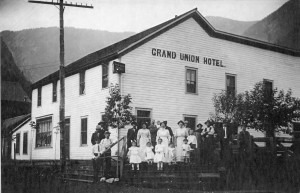
the Grand Union Hotel. On August 29, 1903 they sold it to Robert Herron and Anton Winkler. A few years later Herron sold out his interest to Winkler. The hotel operated under Winkler’s management until a raging fire destroyed it on December 31, 1918.
All that remains today of these two early hotels is the photos, which are on display at the Hedley Heritage Museum.
Birds, Food & Clown at Hedley Reunion
The Hedley Reunion on August 9 demonstrated again that former
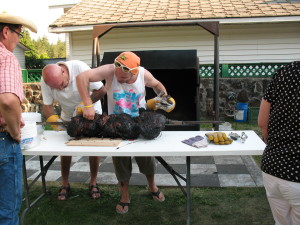
residents have deep roots here. They came from Princeton, Keremeos, the Okanagan Valley, Victoria, and as far away as Alberta and the Maritimes. For some it was an opportunity to connect with former classmates they had not seen since graduating from high school.
Planning for the event began a year ago when Don Armstrong of Hedley and Darryl McDonald of Keremeos started brainstorming about a reunion. They enlisted longtime Hedley resident Judy Turner and made the decision to get serious.
Jan Leake and daughter Cassie delighted children with face painting. In the afternoon the crowd was entertained by Jason Charters of Merritt who bills himself as the “Get Down Rodeo Clown.” He had brought his “assistants”, a couple of wonderfully realistic, long legged and nimble footed marionettes. Attached to him with wires and poles, one danced seductively in front of him and the other behind. Their enthusiasm, energy and sassy demeanour greatly pleased onlookers.
Postmaster Ruth Woodin opened the Beer Garden at 2 pm and toward dinner time appetites were aroused by the enticing aroma of 60 pounds of inside round roast sizzling on the Keremeos Fire Department’s giant barbeque. Head chef was Curtis Armstrong, ably assisted by Kerry Lomax, both of Kelowna.
Removing the meat from the extremely hot rod proved to be a challenge. Don Armstrong needed to run to his home and find several pairs of additional gloves. “We were just a bunch of amateurs doing this for the first time,” he said. A number of salads and desserts were supplied by the ladies of Hedley. With all that good food in their stomachs, guests may have needed a little respite to prepare for the Street Dance.
Music for the dance was provided by the Blackbirds of Keremeos. “They did our kind of music,” Judy Turner said. “People got up to dance, some of whom I didn’t think would. There were about 150 people all over the street.” The high octane Blackbirds brought an aura of vibrant enthusiasm and excitement. All comments about the band were favourable, including from people who enjoyed the music sitting on their patios at home.
When it was over, each of the organizers gave a lot of credit to the numerous individuals who played a role. And each expressed positive thoughts about the year long experience of making it happen. “It was a success for me,” Darryl McDonald said. “I got to meet a lot of people I had not seen since high school.” Judy Turner summed it up with “I had fun. Maybe we’ll do something else next year.” Don said, “everyone was happy. And if there is money left over, we will donate it to the organizations of Hedley.”
The Reunion brought people together and renewed relationships. Also, it once again demonstrated that the citizens of Hedley have mastered the art of throwing an exciting, class act party.
Meeting the Knowles of Hedley
I was vaguely aware that Thomas Cameron Knowles (T.C.) had
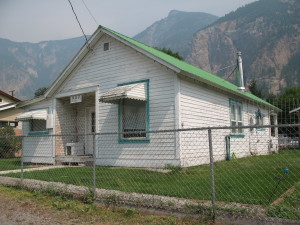
played a key role in Hedley’s history. He was the Postmaster for many years and his wife, Thomasina, played the organ at the United Church for 60 years. Several members of the Knowles family are interred in the Hedley Cemetery. Those still living have re-located to other communities. Having become deeply intrigued by the fascinating history of this little former gold mining community and the people who made it their home, I hoped I might one day have a conversation with a member of the family, even if only by telephone.
Recently Linda and I attended a presentation about the “Hedley Boys”, young men who enlisted and saw combat in WW1. Andy English and Jennifer Douglass, two local researchers collaborated in meticulously gathering information about the lives and military contributions of these Hedley men. We learned that T.C. Knowles was one of the young men who served our country, participating in several major, well known campaigns.
We were sitting in the second row, directly behind a man and two women. All three were strangers to us. Leaning forward in their chairs, they were obviously totally focused and absorbed, not wanting to miss a single word spoken by Andy and Jennifer. They seemed utterly mesmerized by what was being said.
After the presentation we understood why they had been in the front row and had listened so carefully. The two women were Beverley and Anne, daughters of T.C. Knowles. The man was Gordon Lloyd, husband of Anne. They live in Kamloops and had driven here in the summer heat for this presentation. Much of the information on T.C. Knowles had come from Gordon.
After the 2 hour presentation we walked to the Museum with them. As we walked, Gordon pointed to the Hedley Fire Department. “The Red and White store used to be there until it burned down,” he said. “And next to it, where that new house is now, was the butcher shop.” Each of them recalled the town as they had known it when they were young. Both Anne and Beverley graduated from the Hedley High School several years prior to its closing in 1951.
We spent an hour with them over lunch at the Museum, and it was like striking Hedley gold. They were quite willing, even eager to share their knowledge and experiences. “We played ball with Jimmy Douglass,” Beverley said, referring to James (Jim) Douglass, author of the best seller, “JFK and the Unspeakable”. Memories from the past continued to pop up, still fresh and vivid in their minds. They had been at the Hedley cemetery the previous day and Anne named each member of the Knowles family laid to rest there.
Several days after our visit with them, Gordon sent an e-mail in which he mentioned Marlene, as though this was a name familiar to us. I wrote back saying, “I don’t know who Marlene is.” That evening I received an e-mail from Marlene, telling me she is a member of the French family. The Frenches, like the Knowles, are names of some renown in Hedley’s history. And both families understand that it is important to share their early memories so they will not be lost to future generations.
There are rich veins of history in this once bustling gold mining centre. We are fortunate that the Knowles and French families are opening the vaults of their memories so we can all benefit.
What’s Eating Us?
“What’s eating us! Is that an ant colony we’re standing on?”

This scene was captured by Jean Robinson at the Hedley Museum’s Hawaiian Night celebration. We had enjoyed a lavish meal and now anyone wearing a Hawaiian shirt was called up. The ants, understandably, were miffed at us for invading their turf. These men were the unfortunate victims of their displeasure. Standing on the far left, I was quite oblivious of their bad luck. Was I just “in the right place at the right time?” None of us won the prize for the most attractive shirt. That went to a young lad who had the courage to wear a grass skirt as part of his outfit.
Mary Agnes Celebrates 100 Years
Until the day of her birth, the world was a relatively stable place.
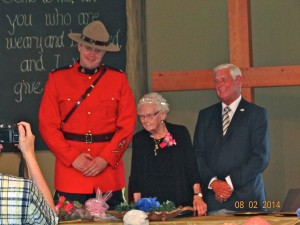
People pretty much trusted their government to get things right and to keep them safe. Communication systems were not as sophisticated as today and when there were contentious issues in other parts of the country, most people were blithely unaware. They needed to focus on earning a livelihood and raising large families.
On August 4,1914, the day Mary Agnes Roberts was born, the conflagration we know as WW I erupted. From that point on, change accelerated and the globe seemed to shrink.
Mary Agnes was the first to ride a bicycle (wood rims) on her block. Her family owned the first radio. Music was played on a hand turned gramophone. Ladies wore pantaloons for swimming.
She was still a pre-teen when Henry Ford introduced his revolutionary Model T in 1924, and then the more advanced Model A.
As a young woman of 25 she fell in love and married George Roberts. They were like-minded in many ways and had almost 26 years together. Their happy marriage ended abruptly when he suffered a heart attack and passed away. This made it necessary for Mary Agnes to develop the character and strength to carry on, in a time when society did not yet have an advanced network of supports for women living without a mate. She did not feel entirely bereft, however. “My husband gave me two wonderful children,” she said. “They have been a great support to me all these years.” In spite of having lost her husband, she was determined to make a difference, especially in her family.
Until a few days before her birthday, one of the remaining items on her “bucket list”, was to ride on a motorcycle. Grandson Tim Roberts has a bike and was delighted to make this wish a reality. Once she had mounted the passenger seat, with the help of 2 men, she expected they would go in a straight line. She was startled when Tim turned the bike around to return to their starting point. Although they stayed on the parking lot of the longterm care residence, she was pleased
At the August 2nd birthday celebration, it was noted that she had made the first financial contribution to the One Way Adventure Foundation. This organization, established to work with troubled teens, was founded by her son Len, and daughter-in-law Jean.
Nearly 100 friends and family members came to the party.Constable Anthony Pankratz, a 6 foot 8 inch Mountie wearing the traditional Red Serge and Stetson, held her left arm as she walked with careful steps to the front of the Baptist church in Princeton. On her right side was Princeton Mayor, Frank Armitage. During the program, messages were read from the Queen, the Governor General of Canada, Premier Christie Clark, John Horrigan, Leader of the Opposition, and other dignitaries.
Toward the end of the celebration, Len invited guests to speak briefly of experiences with Mary Agnes. Several grandchildren expressed appreciation for her many prayers for them. They said, “ this has made a positive difference in our lives”.
Mary Agnes was a member of the generation that contributed significantly to the creation of Canada as we know our nation today. In her personal life she was sustained by her faith in God, the support of her family, and her determination to not stray from the good path she had chosen many years ago. She is inwardly strong, wonderfully resilient, and she possesses a great clarity of purpose.
By her words and example, she has pointed her family and many of us to a path that promises a life of significance and hope. Congratulation Mary Agnes, on 100 productive years!
The Impact Of Walter Paetkau
It was a sunny afternoon and Matsqui Institution’s Citizens
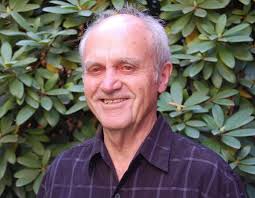
Advisory Committee was on a tour of the prison’s skills training shops. Walter Paetkau, Executive Director of what was then MSA Community Services was walking with me. I respected Walter and his organization highly. He had my immediate attention when he said, “we are getting a government grant to do some projects in the community. You could apply if you’re interested.” Two weeks later I was working for Community Services.
When Walter assigned me to work on a project with seniors, I wasn’t excited initially. For several months I had a partner. Joan was a fun loving red head who laughed easily. She had the looks and personality to be on stage. We organized two town hall meetings that stirred considerable interest among seniors. They liked us and were ecstatic that Community Services was taking an interest in them. When we asked if they would like to have a centre where they could drink coffee, play games and meet people, they quickly said “yes.”
We enlisted several seniors to work on the idea of creating a centre. When we learned there might be money available from the provincial government, I took three senior ladies along to Vancouver to talk with the official who had the power to provide funding. The ladies loved the excursion. One of them insisted on buying my lunch.
We named the centre Friendship House and to my amazement, the seniors persuaded family and friends to donate all the furniture, including a piano. I could plunk a little and Joan had a good voice. For several months we visited the centre once each week. I played the piano and Joan, with her uplifting personality and strong voice quickly created an atmosphere of excitement. The people loved it and I learned that it’s possible to grow old and still be enthusiastic about life.
Knowing I had an interest in writing, Walter began asking me to accompany him to meetings about issues important to the work of the organization. He had a growing vision and the ability to attract people to it. Personal media attention seemed unimportant to him. However, he understood that the media could play a critical role in alerting the community to needs and issues that required attention. In pursuing goals he could be relentless, but he was also able to work patiently at putting pieces in place.
Walter accepted two capable Matsqui Institution inmates as volunteers. One had been successful in a Vancouver radio station until a judge sentenced him to prison for murder. Several individuals on social assistance made a substantive contribution through participation in a work experience program. Walter was able to discern the potential in people, even if their track record was dismal. Observing the blossoming of some of these individuals, I came to realize that through encouragement, guidance and support, a life of failure can be turned into a life of productivity and fulfilment.
Unfortunately, one of the inmates fell in love with a young female volunteer. Desperate to be with her, he persuaded her to run away to Mexico with him. He had concocted a clever scheme to gain control of some Community Services funds. He used the money to finance this poorly thought through plan. His girlfriend returned after a week. He phoned the prison a few days later to say he was coming back. For him it meant no more temporary absences.
The media created a huge uproar and the government withdrew funding for some projects, including the one I was working on. Fortunately, I had learned a lot and felt ready to move on.
Looking back now, I realize it was a stroke of ultimate good fortune to begin this phase of my work life in a position to observe Walter in action. The Community Services experience and the personal influence of Walter Paetkau altered my attitude, outlook and thinking. Walter’s unassuming but forceful leadership style, his values, compassion and perseverance continue to impact my life to this time.
